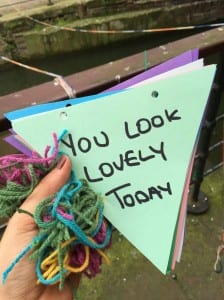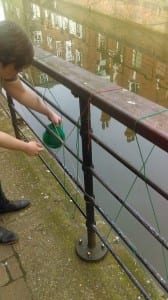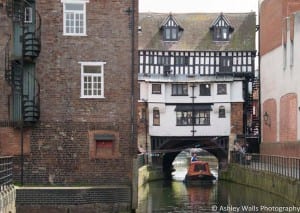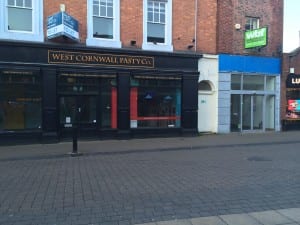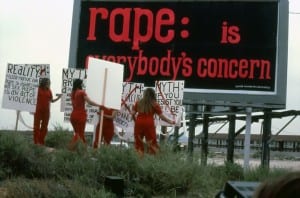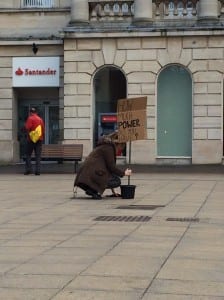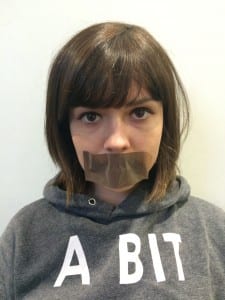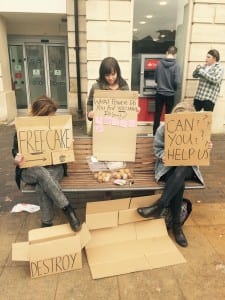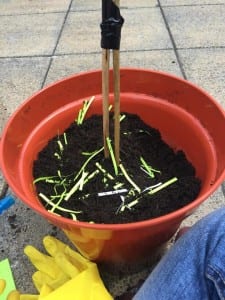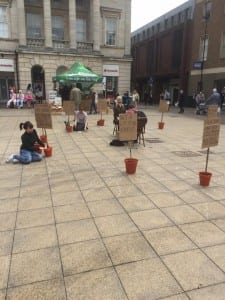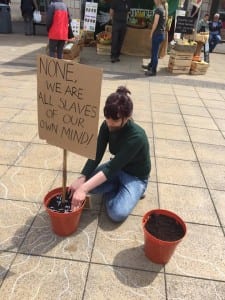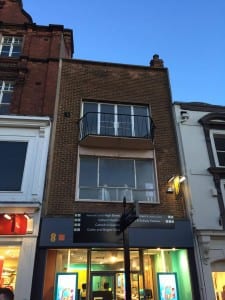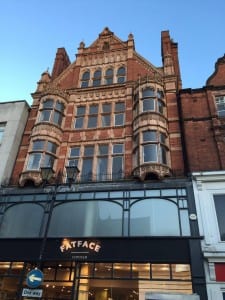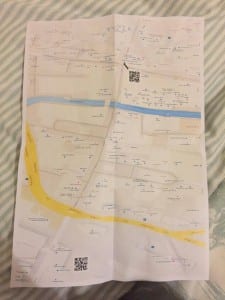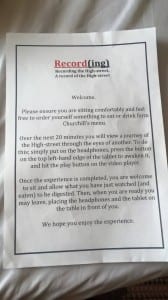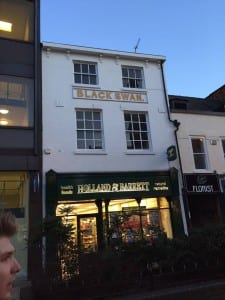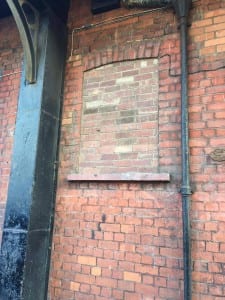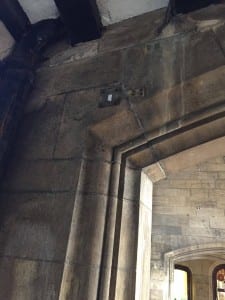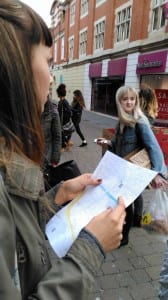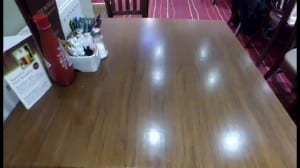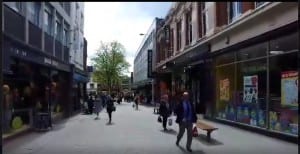Framing statement:
Creating a site specific performance in any context has to have background researching and methodologies behind it to back it up. This is in order to show our influences, as well as making the type of ‘change’ we were trying to make. A variety of terms have stemmed from the term site-specific performance including “‘site-determined’, ‘site-referenced’, ‘site-conscious’, ‘site responsive’, ‘context-specific’” (Pearson, 2010, p.8). Our place being heavily influenced by Mark Auge’s lane and Non-lace theory, we were trying to take a pass-through place ad make it a destination. The methodology of Fluxus seemed relevant to our group, as they focussed on the history of a place before deciding o ideas and themes. Fluxus wanted a piece to be available to the masses rather than just the educated or the knowing. ‘Fluxus was one of the few art movements to use humour throughout history’ (Brecht, 2016). Throughout our rehearsals and even in our final piece, a main focus was on the history of the Brayford, and it influenced our piece heavily. Although our piece wasn’t using humour as such, we were attempting to create a relaxed and positive vibe. Situationist International was another movement we were particularly interested in relating to our piece. This is because one of their main focusses was exploring the city during the 1950s’-1970. This movement was primarily led by Guy Debord. Although they were predominantly a political movement their ideas behind this, for example location, served our piece extremely well. Although the style of our themes were not able to make into a ‘tour’ as such, the aspect of having instillations or fragmented sections was intriguing. We wanted to make it so the different elements made sense and were relevant on their own as well as together. Time was a particularly big issue for our group. To start with we really did not know how long our piece would be able to work for. We were not keen on making it a specific time for no particular reason. We decided to keep our piece going until we felt it right that it should be stopped, which depended entirely on the reaction of the public. According to Peter Brook, it is possible to ‘take any empty space and call it a bare stage’ (Brook, 1995). After we had set our area we began, and continued until there became a long enough gap whereby the public walking past had died down.
Analysis of process:
As a group during our first process of rehearsal, we were all equally intrigued about Carl Avery’s 25 instructions for performance in cities. During this we were given a set of instructions to complete. These instructions were to be taken at your own interpretation, meaning one group could have a completely different outcome to another. With ours, we spent 25 minutes doing these sitting in an elevator whereby our outcomes surprised and equally inspired us. We wanted to research further the idea of proximity within a social context and small places. This lead on to thinking about why random strangers feel safer talking to others in certain environments rather than on a passing street. After leaving our first rehearsal as a group with so many ideas, we were able to expand on these with individual research. ‘It is argued that the process of negotiation –between performance, audience and place, and between site-specificity and `theatreness’ is doubly significant as both the discursive methodology of the thesis and the explorative strategy of the site specific theatre practitioner’ (Wilkie, 2004).
We explored the communal excitement for these ideas by taking a trip into the town to see if this sparked any place ideas or any area caught our eye. As we were about to enter the high street we walked through the glory hole, and we all really liked the aspect of walkways either side of the Brayford. Having a small but practical space became almost essential for us at this point, as we were all so gripped on the idea of proxemics and closeness between strangers. An idea of attempting to somehow bring the two sides together was brought up.

This became a new interesting focal point, as although there was a physical barrier in between the two walkways, the aspect of making two sides interact in some way was intriguing.
Coming away with this new focus, we looked into the history of this area in Lincoln. We found the area used to have a ‘market atmosphere’. This was a place people went to as a destination rather than a passing to get somewhere else. This linked in really well with our next seminar on Mark Auge’s place and non-place. ‘If a place can be defined as a relational, historical and concerned with identity, then a space which cannot be defined as relational, or historical, or concerned with identity will be a non-place’ (Augé et al., 1995). Boats used to pass by, trading goods such as vegetables, wool and fish. Young apprentices also used to stand on ledges wanting and pleading to be employed by boats that passed by. For the period of time the boats were there, it became a place of interaction and had a bustle-like atmosphere. The area didn’t have the enclosed or awkward feel that we were hoping to create. This then made us think about our idea and the relationship it had with the locations history or events. We had realised we’d got quite caught up on our first ideas of using awkwardness and closeness, rather than having an actual reason to stick to them.
Following on from this change of heart, Auge’s place and non-place theory stuck with us. We wanted to explore bringing our chosen site ‘to life’, making it a destination for people to watch a spectacle, rather than a pathway to a different area. We began looking into Marcia Farquhar, who conducted a Live Art Tour. The main focus of her work is to explore the history of a place to create a unique tour in relation to the historic research. Her work is directed towards the audience not knowing what part of the performance is and what is left down to chance.
This is where I picked up on the context of chance, and how valuable ‘in-the-moment’ response can be to a site specific performance. Farquhar’s influences began to become prominent with us the more we researched her. A poignant part of her work is to question the roles of the performers or tour guides, as what effect they can have. ‘Her performance persona in this context is very much herself, the outsider/ insider imbued with the understanding that history is in the process of being made and as such is always ‘half made’(Flaxman exchange, 2013). Although we weren’t trying to change history as such, we were starting to question our own roles and responsibilities within the current ideas we had gathered.
Our initial full idea came together gradually after bringing our individual research of the area together. The word ‘exchange’ cropped up several times, so we decided to continue forward with this. With the idea of the ‘market atmosphere’ as previously explained, we wanted to explore practically how we could pass items to one another making an exchange. However this needed to be one that is viable to a mass audience. We began doing this by simply throwing items such as vegetables and fruit to one another over the barriers, crossing the water. However by doing this, we realised the space we were in just wouldn’t aid the idea of throwing items, as each side was extremely narrow. We then began considering other opportunities for an exchange using the entire space. We wanted to incorporate both walkways either side of the Glory hole into this, meaning the only successful option would be to pass something along a carrying system. ‘The site is a place where a piece should be but isn’t’ (Smithson in Bear and Sharp 1996, 249). It was then that the idea sparked of using wool as the system for carrying items along to each side in order for an exchange to happen. Keeping an authentic feel was essential at this point for us, which is why the wool needed to be the ‘pulling system’ transferring fruit and vegetables.
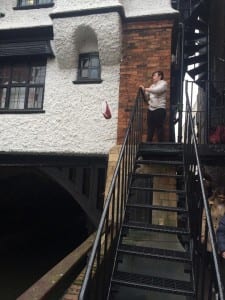
Creating a market-type atmosphere alongside the exchange seemed natural to be happening at the same time. We researched local markets and began adding ‘stations’, making our piece slightly fragmented, however this could have been a positive in aiding our final product. We ended with the exchange of vegetables through a pulling system made from wool, dancing, and creating of fresh orange juice. The orange juice idea was very important to our piece and was particularly unique. The act of pulling a bag of oranges through and along the water was completed, and in turn they were pulled out and squeezed into a jug. Pulling an item through the water with wool attached looked visually exciting, and we had many people ask us what and why we were doing this. With research, we also found that with the Brayford becoming shorter and narrower, people used to place wooden slats over the water to make one bit space, creating a dance floor whereby dances were held.
After completing these stations together, we began to see negatives to this option. The main issue was space. As our space was so long but lacking in width, it felt like we were almost too spread out for it to work. It became 3 different pieces which was not what we were aiming for. We also found that not incorporating the audiences reactions left us lacking in content for our piece. Using our contextual and theoretical influences we previously researched, we began to see how we could keep our theme of exchange, but edit our piece accordingly. Keeping with the main prop of wool we thought we could make an exchange of something by wool a poignant part of our final piece. Coming to the conclusion that dancing felt forced and acted, we decided to take it out. We were very hesitant of taking out the aspect of pulling an item along the Brayford, as it was so visually pleasing. So now we needed to decide on an item to pull along our wool system, and something to drag along the water. As well as this, we wanted to add a little focus on the public, as before in trials, we hadn’t put enough thought into how much their reactions can improve and add to a final piece. A thought came to mind of giving the audience something as part of an exchange. As we were trying to keep the market-place, celebratory feel to it, it had to be something positive we were giving them. Dragging something through the water also made sense to us for historical and visual reasons. Dragging an item to the pulling system to exchange sides in order for an audience member to retrieve it was attempted. This meant that every aspect of our piece would now be tied together in some way, and without one, the other wouldn’t be able to work.
Keeping the celebratory atmosphere involved pleasing the public that passed. An idea was pushed forward of compliments. Giving passing members of the public a compliment in some way was positive and would add happiness by chance. We began by handing out compliments on paper via our wool hand-made pulling system across the Brayford. The response to this was extremely positive, and we felt people left the area with a happier feel than maybe before. To make the compliments a ‘process’ rather than just an action, we decided to trying walking them through the Brayford in glass bottles. This was to signify the journey of the boats before they used to exchange goods in the past. The compliment went on a journey before it was given to someone. This idea was extremely successful on trial and we decided to stick and add more detail to it.
Performance evaluation:
Friday 6th may 2016 was our performance day. We began setting up from 9:30am, as the process of placing the wool was to take a considerable amount of time. We weaved the wool through the barriers of the Brayford each side of the walkway. We then continued on to make a ‘spider-web’ like shape above the Brayford, going across each side. This was alongside the pulling system for ferrying the compliments across the water. After rehearsing this previously we were able to successfully set this up efficiently.

Our other props were previously put together, so we began our piece. As an individual, I found it particularly hard to take away the aspect of acting within our piece, as it definitely needed to be about the visual representation of our piece rather than this. Speaking as a group after, everyone found this particularly difficult however I feel we managed to succeed in doing this. At times, for me, our piece felt almost too fragmented, as we were working with such a long space. However, with this came the bonus of being able to really use and feel the space we were in whilst we were in the moment of our piece. We found that the two group members dragging the bottles were asked by public members what they were doing. Walking further and seeing others pulling notes across the Brayford, they were then able to connect both pieces together. I really liked this concept as it almost seemed like two separate occurrences until you are able to see both closer and working as one group. During the part of our piece we were being marked, two boats passed through part of the water, which resulted in us having to lift our wool that was tied to each barrier, higher in the air. We had previously prepared for this, and was hoping it would happen as it would aid our piece. Whilst the boat was passing under the string, it brought out a great visual piece of art, as it seemed we were celebrating the boats passing through. This also linked in closely to the history of the area, with exchanges being made from boats rather than across string. Whilst the boats were passing we all stopped actions and stood still holding the string above them, as though the boat had a higher authority status than us. This lasted around 20 seconds each time, and the visual aspect of it was a complete success even though it was really chance of this actually happening during a slotted time period.
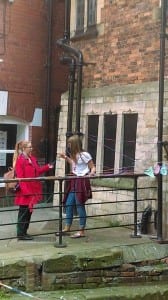
Giving out compliments via paper to the public was also positive in the majority. Many people then went onto ask us about the reason behind this, whereby we were able to inform them about our ‘exchange’ and prior research behind this. We were then able to include our idea of bunting within our reasoning. Placing the compliments along a line of wool, creating a bunting-style of compliments, added to our running theme of celebration and adding happiness to our site. This was placed higher on a slant, so passers-by were able to see and read the compliments as they were walking past. This meant even if they did not receive a physical compliment on paper, they were able to read some and maybe relate it to themselves.
(Word count: 2576)
Work cited:
Augé, M., Augé, M., Howe, J., Auge, M. and Aug, M. ? (1995) Non-places: Introduction to an anthropology of supermodernity. New York: Verso Books
Wilkie, F. (2004) Out of place. Available at: http://epubs.surrey.ac.uk/823/1/fulltext.pdf (Accessed: 4 May 2016).
Brecht, G. (2016) Fluxus movement, artists and Major Works. Available at: http://www.theartstory.org/movement-fluxus.htm (Accessed: 12 May 2016).
Pearson, Mike (2010) Site-Specific Performance. London: Palgrave Macmillan
Brook, P. (1995) The empty space. Available at: https://www.penguin.co.uk/books/13520/the-empty-space/ (Accessed: 13 May 2016).
Flaxman exchange (2013) Available at: http://www.marciafarquhar.com/flaxman-exchange/ (Accessed: 13 May 2016).
Bear, L. and Sharp, W. (1996) ‘Discussions with Heizer, Oppenheim Smithson in Jack Flam’ (ed.) Robert Smithson: The collected writings, Berkeley, Cal: University of California Press.
Stokes of Lincoln (2014) History of the High Bridge. [Website] Lincoln. Available from http://stokes-coffee.co.uk/history-high-bridge/ [Accessed on 10 May 2016].
